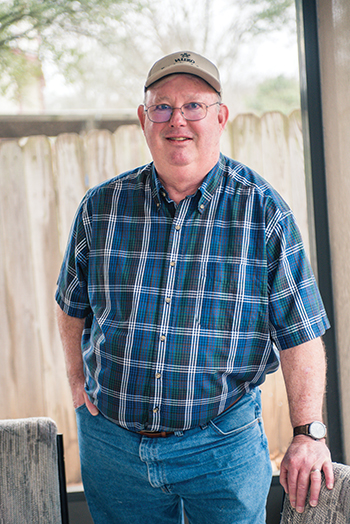Cutaneous Squamous Cell Carcinoma Survivor
Science & Support: A Life-Saving Combination
 A lifetime of ultraviolet (UV) exposure from the Texas sun left Dale Biggs with an extremely aggressive case of a type of skin cancer, cutaneous squamous cell carcinoma, at age 61. After exhausting all his options, he entered an immunotherapy clinical trial that proved nothing short of a miracle. Dale credits his survival to his innovative medical team and the love and support of his wife.
A lifetime of ultraviolet (UV) exposure from the Texas sun left Dale Biggs with an extremely aggressive case of a type of skin cancer, cutaneous squamous cell carcinoma, at age 61. After exhausting all his options, he entered an immunotherapy clinical trial that proved nothing short of a miracle. Dale credits his survival to his innovative medical team and the love and support of his wife.
For the sake of background, I grew up in Wichita Falls, Texas, so I was accustomed to the heat. Whether I was at the swimming pool or working at a summer job, I was always outdoors. And I never used sunscreen because 100-degree temperatures were just part of life.
Between 1984 and 2015, I had dozens of scaly actinic keratosis patches and bumps removed from my head and neck area. In December 2015, after having one of the bumps removed, a biopsy came back malignant. I had cutaneous squamous cell carcinoma. Within two weeks, three more bumps appeared on my head. One was big, the size of a golf ball cut in half and glued to my head. The others were the size of a jelly bean. I wore a ball cap to cover them.
I was sent to a surgical oncologist who was stunned when I took off my cap. It took major surgery to remove all the tumors and most of my scalp, followed by complicated reconstructive plastic surgery. I also had a port surgically installed so I could begin chemotherapy after I healed from the surgery.
I began chemotherapy in January. Big bags of medication that hung on IV poles flowed in through my port. I lost my hair and my sense of taste and had diarrhea, and hard tumors continued to grow on and around my head. One near my ear was so big it closed off my ear canal. Another on my jaw was egg-sized. The drugs weren’t working, and my heart sank when my oncologist told me he didn’t know what else to do. He took my case back to a pool of doctors for their input.
A few days later, the consensus was that I try a clinical trial at a local leading-edge cancer center. The doctor on the trial team was very up-front. He told me the experimental immunotherapy being used had worked on only 30 percent of the people who took it. He then laid out all the potentially serious side effects that could happen. I know how bad things can be and have always chosen to look at the good, yet this was overwhelming. On the way home, I told my wife it might be time to take a look at my will.
I still had my port, so the plan was to come in for an infusion weekly for eight weeks. At this point, a ball cap didn’t cover all the tumors so I moved on to wearing a beanie. I expected the immunotherapy to come in big bags like the chemotherapy. Instead, it came in an itty bitty 8-ounce bag. For the next eight weeks, about 45 other cancer patients and I sat in recliners, getting our treatments and getting to know each other.
I didn’t have any side effects, and very soon after I started the trial something began to happen. The big, hard tumors were getting soft. At the end of the eight weeks, I could wear a ball cap again. I wore it to my follow-up appointment. When I took it off, the doctor took one look and picked up the phone to call the director of the trial. “Come see a miracle,” he said.
The doctors expect what they call a durable response, meaning my immune system is retrained to fight the cancer. Hopefully it will continue to do so without any more treatments. To be clear, the cancer isn’t gone completely. Every time I go for a follow-up, something has to be removed. But the difference between then and now is night and day.
The trial was successful overall and the drug was fast-tracked by the U.S. Food and Drug Administration. It is now available to anyone who qualifies for it. That thrills me because my treatment road was not easy. Over the years, I saw many doctors. I had several surgeries, including a delicate skin graft and plastic surgery, not to mention the fear I felt when nothing treated the cancer. I find great hope in the fact that someone else can see if they can get this therapy.
I’m also thankful that it will change how the effects of the disease play out for loved ones. My wife, Donna, is my guardian angel. She went to every doctor’s appointment and made sure I did everything I needed to without ever really showing me how scared she was. I don’t wish what she and the rest of my family went through on anyone.
If my story can help encourage someone to try a clinical trial, to try for that miracle not just for themselves but for others down the road, then I’m happy. I’ll leave you with these recommendations:
- Educate yourself about your diagnosis as best you can using trustworthy resources.
- Consult with more than one doctor. Collectively, they can come up with better solutions.
- Continue to hope for the best.


